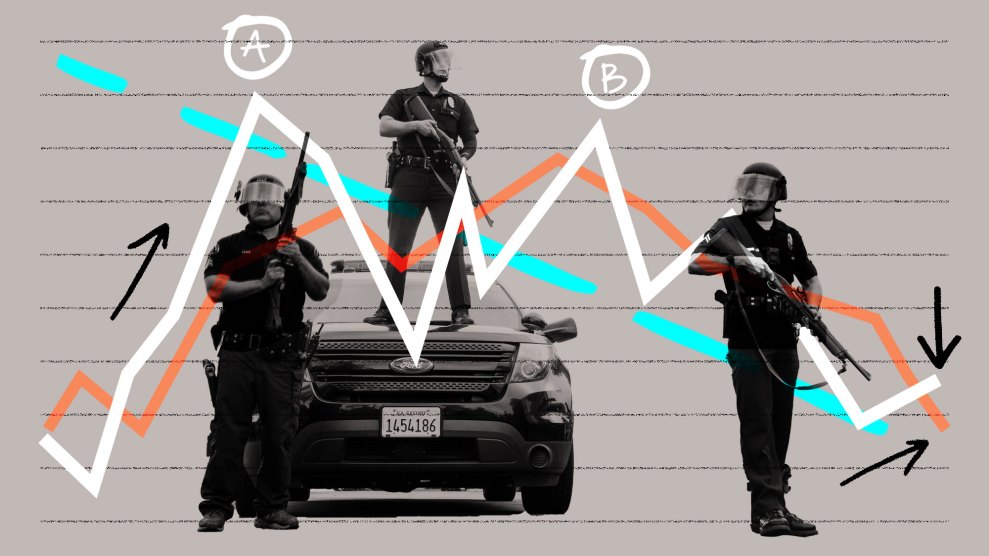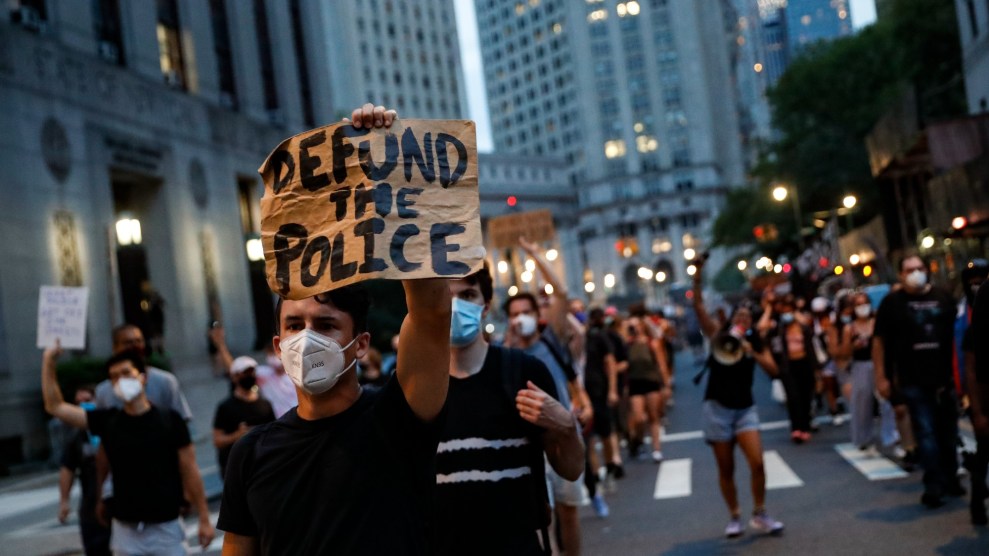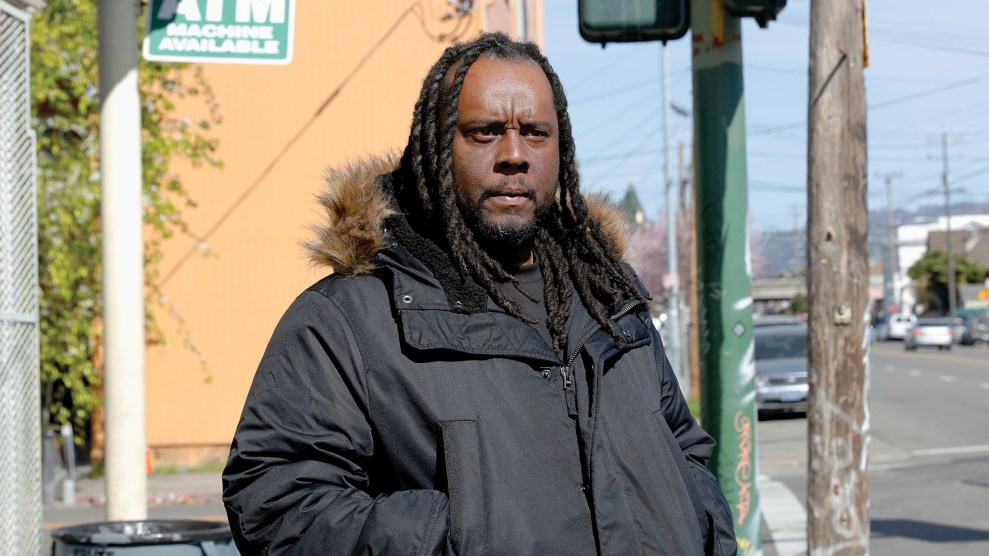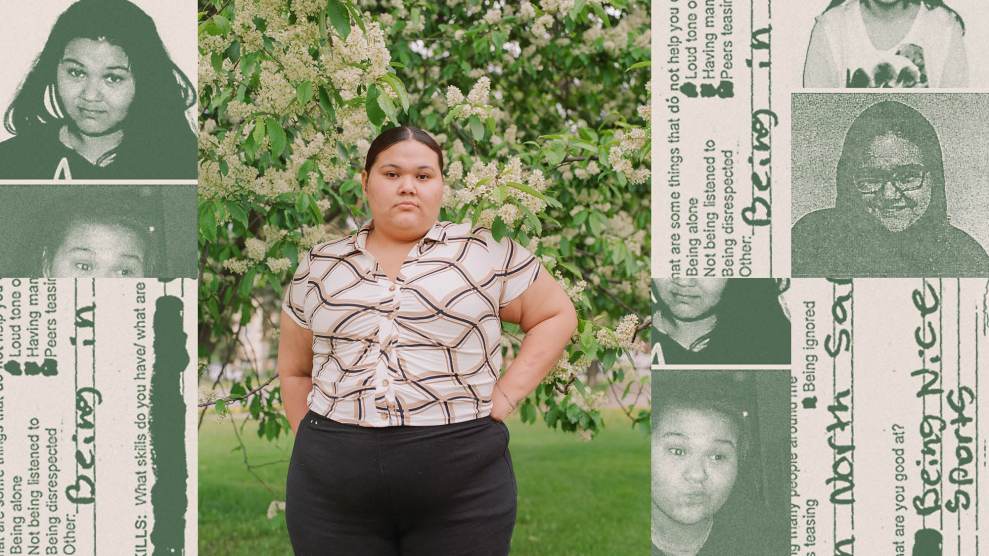
Mother Jones illustration; Kent Nishimura / Los Angeles Times via Getty
Homicides across the United States rose by an estimated 30 percent in 2020, the largest one-year increase on record, according to recently released data from the FBI. But don’t jump to conclusions about what that means.
As soon as the FBI shared this eye-popping statistic in late September, a flood of fear-inducing headlines made it seem like Americans are now living through a massive wave of violence. Police chiefs, mayors, and journalists quickly speculated about the possible causes for the uptick, often blaming (without evidence) protests to defund law enforcement and stop police brutality.
Don’t believe them. “It is very advantageous for police to weaponize this tragedy,” says Scott Hechinger, a former public defender in New York who now leads the advocacy group Zealous and has criticized the New York Times, NPR, and others for their coverage of the killings. Fearmongering about crime has for decades been a way for politicians and other officials to funnel more money to cops and prisons, win elections, and undermine Black people’s popular protests for civil rights. “But,” says Hechinger, “it ignores a lot of truths.”
Here, we debunk the most pervasive myths about murder rates during the pandemic.
Myth 1: Murder rates are off the charts.
Actually: They’re nowhere near historic highs.
Let’s get straight about the data. In 2020, the United States recorded an estimated 21,500 homicides, or about 4,901 more than the year prior. Most were from shootings.
We shouldn’t downplay those numbers, because each death represents someone who didn’t make it home to their families, disproportionately in Black and brown communities. But it’s important to also keep the numbers in perspective to avoid fueling tough-on-crime policies that have historically harmed these very same communities.
So, here’s the key context: Even after the big increase in killings last year, Americans are still much less likely to be murdered today than they were in the 1990s. Since then, homicides have generally been trending downward. According to the Guardian, the homicide rate across big cities is close to half what it was a quarter century ago: New York City saw 468 killings last year, compared with more than 2,200 killings in 1990. Los Angeles saw 350, compared with more than 1,000 a year in the early 1990s.
Of course, these encouraging trends aren’t true in all places. Some smaller cities like Albuquerque, Indianapolis, and Milwaukee saw record killings last year, according to the New York Times. But long-term data shows that generally speaking, things have been getting safer. “Though the spikes are alarming, we are not approaching the very high incidence of gun violence that we experienced during the height of the drug wars and the crack cocaine epidemic,” says Mike McBride, a pastor in California who is a national leader in the movement to address urban violence with public health approaches. With the organizing network Faith in Action, where he works, he helped the city of Oakland cut shootings in half from 2012 to 2018 before seeing an uptick again during the pandemic.
In 2021, killings are still rising nationally, but at a slower clip. As of this summer they were up 10 percent compared with 2020, according to preliminary data on dozens of cities.
Myth 2: We’re in the middle of a crime wave.
Actually: Overall crime is down.
Taken as a whole, crime has been dropping for about 18 years straight. In 2020, “major crimes,” a broad category that includes various violent crimes and property crimes like rape, armed assault, robbery, burglary, car thefts, and murder, dropped by an estimated 5 percent, according to the FBI. (The Justice Department’s annual National Crime Victimization Survey also suggested many types of crimes fell.)
It’s not just progressive activists like Hechinger making this point. “We’re not in a crime wave, and we’re not in a violent crime surge,” says Jeff Asher, a data analyst in New Orleans who formerly worked for the CIA and the New Orleans Police Department, and whose recent studies on homicides have been widely cited. “It’s a very specific problem,” he says of the gun violence in 2020, cautioning not to use broad brushstrokes to paint a picture of what happened.
It’s homicides in particular that increased so sharply, even as many other crimes fell.
Myth 3: Anti-police protests caused the homicide surge.
Actually: Nope. No proof.
This myth has been recycled in many forms, on many platforms. In one particularly cringeworthy op-ed last month, columnist Henry Olsen, writing for the Washington Post, posited that shootings rose in 2020 at least in part because anti-police protests tanked morale among law enforcement. “Police are retiring or quitting in droves,” he wrote. A reduced police presence, he speculated, might have encouraged criminals to shoot people, especially in Black and Latino neighborhoods. (Victim-blaming, anyone?) “It’s the perfect storm,” Albuquerque Police Chief Harold Medina told the New York Times, citing the fallout from anti-police protests as one of many factors that contributed to murders.
The theory these men are promoting—that protests cause cops to withdraw or react in some way that then causes murders to spike—has a name: the Ferguson effect. The idea became popular in 2015 and 2016, when homicides increased after people took to the streets around the country to protest Michael Brown’s killing by a police officer in Ferguson, Missouri, in 2014.
The thing is, the theory is questionable: A nationwide study in 2019 by criminologist Richard Rosenfeld at the University of Missouri, St. Louis, found that police arrested fewer people after the Ferguson protests, but that this change did not cause the subsequent increase in murders in 2015.
More recently after the George Floyd protests, Asher, the New Orleans data analyst, examined 60 cities and found no correlation between the number of Black Lives Matter protests in a particular place and the size of that place’s homicide surge in 2020. “The short term increase in homicides, as well as the continued decline in other major crimes, was universal across the United States—in cities large and small, in states red and blue, in cities that had protests for Black lives and those that didn’t,” says Hechinger, the former public defender. And shootings began to rise even before a Minneapolis officer murdered Floyd in May 2020. This suggests that even if the protests had not occurred, we still would have seen an increase in murders last year, says Asher. He concedes that homicides rose more substantially amid the protests, but they stayed elevated throughout the rest of the year. “Whatever caused it was something that persisted through the first part of 2021 as well.”
Some criminologists speculate that the pandemic played a role: Violence prevention programs that previously relied on face-to-face interactions couldn’t work as well because of social distancing; more people were unemployed and struggling with their mental health; and gun sales soared. But for the moment, it’s impossible to know exactly what caused the uptick in killings. That’s because short-term statistics like the ones from the FBI “are notoriously volatile,” says Hechinger. “We can hypothesize what it might have been, but to say anything with any confidence is pretty impossible at this point,” agrees Asher.
Myth 4: Homicides surged because we defunded the police.
Actually: Nope. And many cities invested more in police.
Again, homicides rose all over the country, even in places that saw no change to their law enforcement budgets. The city of Louisville, Kentucky, for example, where officers fatally shot Breonna Taylor in her home, saw a record number of community killings in 2020, even though police spending there remained steady. Tampa, Florida, also saw shootings rise, though officials there increased the police budget by about 8 percent. There are countless other examples.
Also, to set the record straight, defunding police has not been a general trend across the United States, even after a record number of Americans took to the streets demanding it.
It can be tricky to parse the facts here, because plenty of city councils did make headlines by voting to cut money from police budgets after the George Floyd protests. According to a Bloomberg CityLab investigation, the 50 largest US cities collectively reduced their spending on cops by about 5 percent. But because city councils were also cutting other types of spending as a result of the pandemic’s economic toll, law enforcement spending as a share of general expenditures rose slightly in these 50 cities, according to CityLab‘s investigation. And many cities that initially voted to reduce cop budgets later balked: The Minneapolis City Council cut nearly $8 million from the police department last year after Floyd’s murder, but they later added $6.4 million back into the department’s budget to hire more officers.
In other words, as Fordham law professor John Pfaff put it, defunding the police didn’t lead to more murders, because defunding the police often didn’t happen: “This was, by and large, a homicide spike that happened on the status quo’s watch,” he wrote on Twitter.
Some experts speculate that even if defunding wasn’t to blame for the gun violence, the protests may have spurred a “police legitimacy crisis” that caused killings to rise. The thinking here is that if protests convinced more people to stop trusting the police, fewer people called the police for help. It’s a plausible theory that’s been cited by criminologists like Thomas Abt, the author of Bleeding Out, a book about community gun violence. Even Rosenfeld, the Missouri criminologist whose research was used to debunk the Ferguson effect after Michael Brown’s killing, has since stated that he thinks protest-induced mistrust of police could spur crime.
But if the theory is true, it’s hard to explain how a lack of trust in police would only cause one type of street crime—namely homicides—to rise last year, while other types fell. Also, the police legitimacy crisis isn’t a new phenomenon: Communities of color have long been wary of calling cops, even during years when homicides were on the decline.
Myth 5: More police and prisons will solve the problem.
Actually: Investing in public health might be a better bang for our buck.
This last myth follows from the previous ones, and it’s not just a talking point of conservatives. In a statement in June, the White House suggested that cities should fight gun violence by using federal coronavirus relief funds to “put more police officers on the beat,” in addition to supporting evidence-based violence prevention programs that aim to stop shootings by connecting people to jobs, housing, and mentors. “This is not a time to turn our backs on law enforcement or our communities,” President Biden said at the time.
Some journalists who have extensively covered the criminal justice system seem to agree that more, better-trained cops can help. Vox‘s German Lopez recently summarized several crime studies that led him to conclude that police officers should play some role in reducing murders; they can deter violence more quickly than social services can, he argues.
In contrast, some progressive activists contend that police officers are pretty much incapable of deterring crime. New York City, for example, saw crime levels drop when it reduced the number of cops on the streets and they started making fewer arrests.
The research is mixed, and the truth is likely somewhere in the middle. Pfaff, the Fordham professor, summed it up nicely in a recent Slate article, where he argued that policing does appear to deter some degree of crime, but at a major cost. He writes:
There’s an increasingly popular talking point among some progressive reformers that policing has no impact on crime. This is unambiguously false. But what is, I think, the best study on this issue to date paints a nuanced, and complicated, picture of policing. Its results suggest that to eliminate one homicide, we need to hire 10 police officers, who will then prevent ~15 higher-level arrests and ~200 serious felonies, almost all via deterrence. But these officers will also make ~70 more low-level arrests—which a recent study from Boston suggests could impose net social harms—and cause ~8 more police use-of-force incidents.
This means we should think more carefully about the opportunity cost of policing. Even if more police reduce crime, given its various collateral costs—and benefits!—is policing the best place to spend another dollar? One study suggests that a dollar spent on policing reduces crime by ~$1.60—which may seem effective, until we note that a different study indicated that a dollar spent on drug treatment reduced the social costs of just crime by ~$4—on top of the health benefits of treatment, which, given what we’ve just seen about drug overdose deaths, are likely quite substantial as well…Similarly, interventions like violence interrupters that may have less solid empirical evidence of their crime reducing impact than policing almost surely also have fewer collateral costs than policing.
Put another way, perhaps cities would get more bang for their buck if they reduced their spending on law enforcement and shifted some of that spending to public health—which is exactly what the defund movement calls for. “[I]nvesting more in policing…crowds out other spending, often on mental health care and drug treatment centers—the sorts of interventions that reduce deaths by suicide and drug overdose,” Pfaff writes. Those interventions could have a bigger impact when you consider that Americans today are much more likely to die by suicide and drug overdose than by homicide: In 2019, about 12,500 people younger than 40 died from homicides, compared with about 18,500 who died by suicide and about 28,000 who died from accidental drug overdoses, according to Pfaff, who cites the Centers for Disease Control and Prevention. And the preliminary data from 2020 suggests that while the total number of homicides across all ages rose by about 5,000 in the United States, the total number of drug overdose deaths rose by about 20,000.
Other studies show that arresting more people and throwing them in prison likely won’t reduce killings. A recent meta-analysis of 116 studies, published by the University of Chicago last month, concluded that imprisoning people either has no effect on their likelihood of committing another crime or slightly increases it. Another paper, published recently by the Center on Juvenile and Criminal Justice, found that California counties that locked up lots of people per capita experienced twice as many homicides per capita than lower-incarceration counties.
“We cannot allow this once-in-a-generation pandemic to become the fuel for failed public safety strategies of the past,” adds McBride, who helped reduce shootings in Oakland by encouraging the city to invest more in social services. “I am very much against any form of increasing policing, even in the face of this spike in violence. What we ought to do is move away from the knee-jerk reaction that Black communities and brown communities can only be controlled by the domination of a largely white law enforcement profession. We must reject that.”
“We, as a society, spend more on policing, prosecution, and prisons than any other society in the history of the world,” adds Hechinger. “And still, we are not the most healthy or safe society in the history of the world. And so we should be questioning why that is.”












